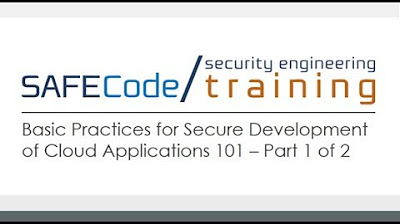Cloud Security Tutorial For Beginners | What is Cloud Security?
Summary
TLDRIn this video, the importance of cloud security is emphasized as businesses increasingly migrate to cloud environments. It covers the fundamentals of cloud computing and security, explaining the shared responsibility model between providers and users. Key aspects such as data protection, access control, and network security are discussed, alongside prevalent threats like data breaches and insider threats. The video outlines essential best practices for safeguarding cloud assets, including strong access controls, encryption, and employee training. Viewers are encouraged to stay vigilant and prioritize security to thrive in the evolving tech landscape.
Takeaways
- 🌩️ Cloud security is crucial for businesses as they transition to cloud technology; ignoring it may lead to obsolescence by 2028.
- 🔒 A shared responsibility model exists in cloud security, where both the provider and customer must ensure safety.
- 🛡️ Key aspects of cloud security include data protection, access control, network security, and compliance with regulations.
- 🚨 Common threats to cloud security include data breaches, insecure APIs, insider threats, and denial-of-service attacks.
- 💻 Understanding cloud computing basics, like IaaS, PaaS, and SaaS, is essential for effective cloud security management.
- 🧩 Implementing strong access controls and identity management is critical to preventing unauthorized access to cloud resources.
- 🔑 Encryption is vital for safeguarding data both at rest and in transit, acting as a protective measure against data theft.
- 🔍 Continuous monitoring and logging of cloud activities help detect potential security threats in real time.
- 🛠️ Regular patch management and vulnerability scanning are necessary to address security weaknesses and prevent exploitation.
- 👥 Employee training is essential to create a security-conscious culture and equip staff to recognize and respond to threats.
Q & A
What is cloud security, and why is it important?
-Cloud security is the practice of protecting data, applications, and infrastructure in cloud environments from unauthorized access and damage. It is crucial because as more businesses move to the cloud, they become more vulnerable to cyber threats. Effective cloud security ensures data confidentiality, integrity, and availability.
What are the main service models of cloud computing?
-The three main service models of cloud computing are: 1) Infrastructure as a Service (IaaS), where users rent basic computing resources; 2) Platform as a Service (PaaS), which provides preconfigured environments for application development; and 3) Software as a Service (SaaS), where users access software hosted and managed by the cloud provider.
Can you explain the shared responsibility model in cloud security?
-The shared responsibility model outlines that both the cloud provider and the customer have roles in securing cloud environments. The provider secures the underlying infrastructure, while the customer is responsible for securing their applications, data, and operating systems deployed on that infrastructure.
What are some common threats to cloud security?
-Common threats include data breaches, unauthorized access, insecure APIs, insider threats, misconfigurations, denial of service (DoS) attacks, and advanced persistent threats (APTs), where hackers infiltrate systems over time to extract data.
What best practices can businesses implement to enhance cloud security?
-Businesses should implement strong access controls and identity management, use encryption for data at rest and in transit, segment their networks, regularly patch and update systems, conduct vulnerability scans, and provide employee training to recognize security threats.
What is the importance of data protection in cloud security?
-Data protection is vital for safeguarding sensitive information from unauthorized access and ensuring that data remains available. Key components include encryption, regular backups, and disaster recovery plans to mitigate data loss in case of incidents.
How does network security contribute to overall cloud security?
-Network security protects cloud resources by ensuring secure communication channels, monitoring traffic, and implementing segmentation strategies to prevent unauthorized access. This reduces the risk of attacks and ensures only legitimate traffic reaches cloud services.
What role does employee training play in cloud security?
-Employee training is crucial because human error is a significant factor in security breaches. Educating employees about phishing, password management, and secure data handling helps create a culture of security awareness and reduces the likelihood of incidents.
What is meant by 'compliance' in the context of cloud security?
-Compliance refers to adhering to regulations and standards relevant to data protection, such as HIPAA, PCI DSS, or GDPR. Organizations must ensure their cloud environments meet these legal and regulatory requirements to avoid penalties and protect sensitive information.
What can organizations do if they experience a security incident in the cloud?
-Organizations should have an incident response plan that includes detecting, responding to, and recovering from security incidents. This involves monitoring for suspicious activities, executing predefined response protocols, and conducting post-incident analysis to improve security measures.
Outlines

This section is available to paid users only. Please upgrade to access this part.
Upgrade NowMindmap

This section is available to paid users only. Please upgrade to access this part.
Upgrade NowKeywords

This section is available to paid users only. Please upgrade to access this part.
Upgrade NowHighlights

This section is available to paid users only. Please upgrade to access this part.
Upgrade NowTranscripts

This section is available to paid users only. Please upgrade to access this part.
Upgrade NowBrowse More Related Video

A New Perspective on Resource-Level Cloud Forensics

20 Identidade, acesso e segurança - Parte 1

FIOT | Unit 2:Integration of sensors and actuators with Arduino | B.Tech CSE R18 JNTU syllabus

Segurança em Ambientes de Nuvem

Cyber Security Pada Cloud Platform. Part 01

SAFECode Basic Practices for Secure Development of Cloud Applications 101 Quiz Part 1 p2
5.0 / 5 (0 votes)